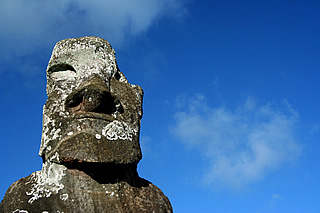

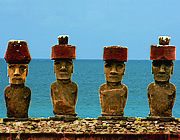
Surrounded by nothing but ocean for thousands of miles Easter Island is certainly worth the effort of getting here, rewarding visitors with the famous enigmatic statues, isolated or standing in linear groups all over the island, extinct volcanoes, a tempestuous sea and beautiful coastline.
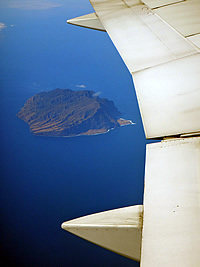
Easter Island is unique in our experience - a tiny dot in the ocean littered with the evidence of an enigmatic civilisation whose ways of life and worship can only be guessed at.
It was our first destination on a wide-ranging trip to South America. From Santiago in Chile it's five hours to Easter Island, over 3500 km west. In a beautiful blue sea we spotted only one reasonably-sized island!
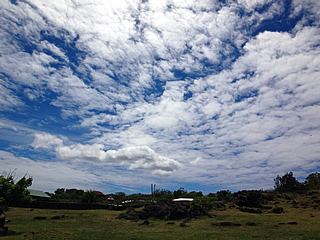
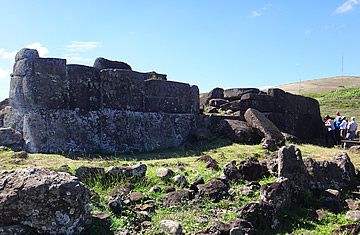
The runway at the airport on Easter Island is immensely long, extended to accommodate a Shuttle landing if it were ever required - it wasn't.
We were greeted with flower garlands and driven a short distance to our hotel, the Puku Vai, quiet with a very nice, industrious manager and his young family. Rather distant from the town of Hanga Roa so we found ourselves doing quite a bit of walking to and fro.
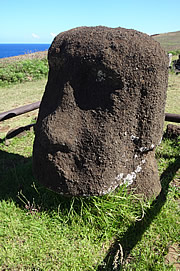
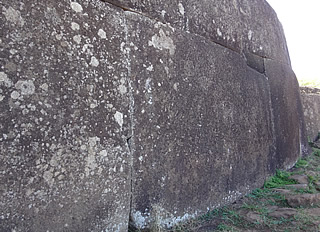
It is thought that the first settlers arrived from the Polynesian islands thousands of kilometres to the west. Traditionally these people would live on an island until it became too densely populated then some would take their boats and head east until they reached an uninhabited island. Unfortunately for the Easter Islanders, they set out from the eastern edge of the larger density of islands and their journey would have been rather longer than anticipated.
Another suggestion is that Peruvians populated the island, arriving in boats from the east. At Ahu Vinapu - actually two shrines: Ahu Vinapu I and Ahu Vinapu II - a wall at Ahu Vinapu I built with massive basalt blocks weighing up to 2 tons, very precisely fitted together and reminiscent of Inca stonework, is given as evidence to support this theory.
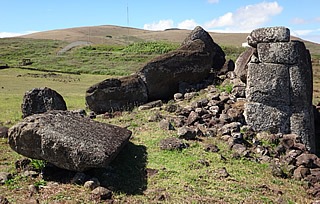
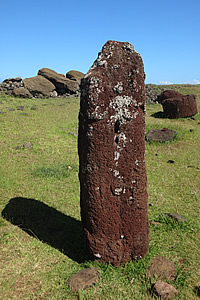
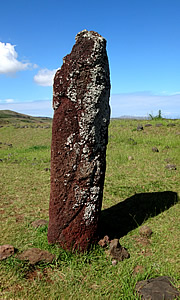
Typically the statues, called moai, which stand on platforms, called ahu, are male, but Vinapu II is interesting for the only representation of a female, although weirdly it has, or had, two heads. We had to take our guide's word for this as they were very difficult to make out. It has small breasts, a navel, and is also unusual in that it is carved from the red volcanic rock usually reserved for the topknots or pukau.
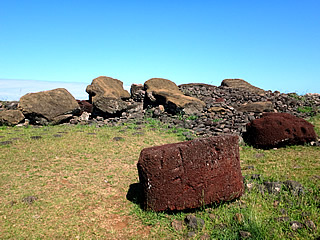
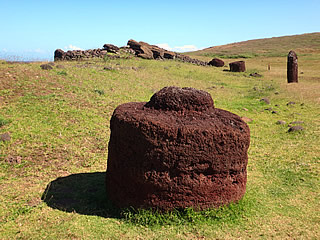

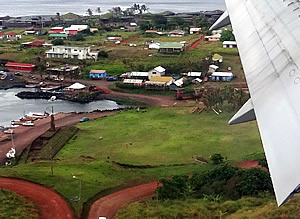
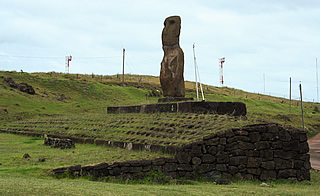
The earliest archaeological evidence for people on the island does not appear until around AD 800, though some estimate that the first settlers arrived 350 years earlier.
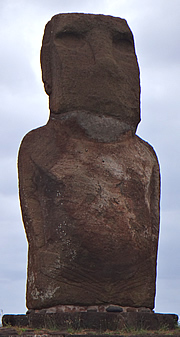
That first afternoon we walked west to the coast and the little fishing harbour of Hanga Piko. It was a cloudy day and we made the big mistake of not wearing hats - the UV index was actually extremely high and Andrew in particular suffered!
The distinctive stone statues, called moai and thought to represent clan ancestors, are erected in shrines all over the island. The larger and more imposing the statue, the greater the power of the clan.
There are more than 900 scattered around the island, two remain at Hanga Piko's shrine Ahu Riata: one lying in the grass and another standing on a long platform facing away from the sea, both rather weather-worn. As with all bar one of the statues these had no eyes.The arms of the standing statue and its hands could be seen very clearly, folded under a rounded stomach.
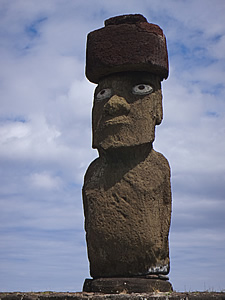
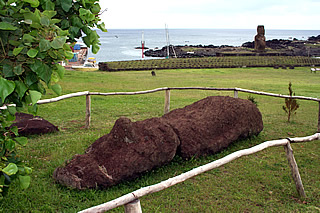
Further around the coast is the only example of a restored moai with eyes and a red topknot or pukau. This is Ahu Ko Te Riku at the Tahai complex of shrines just north of Hanga Roa, a place we were to return to several times during our stay on Easter Island. About six metres tall and facing inland it is an impressive sight. Moai are on average 4m tall and weigh around 12 tonnes and most date from the 13th to the 15th century AD.
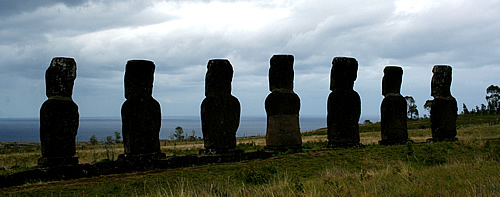
In fact, the only moai not to face inland are at the shrine of Ahu Akivi, seven restored moai staring resolutely out to sea. These are thought to represent the very first settlers on the island looking back in the direction from where they came.
These moai are not so elongated and have no topknots. The eye sockets are very well-defined.
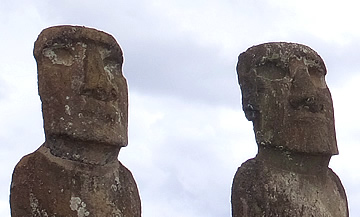
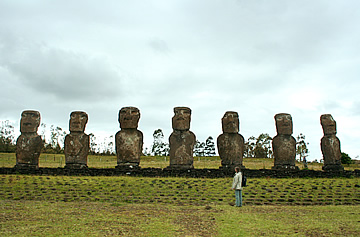
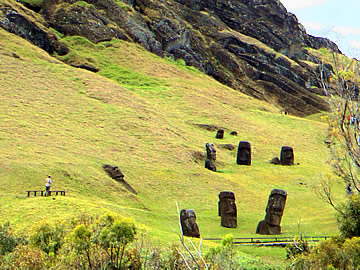
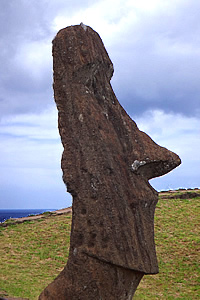

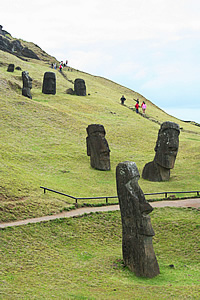
As clans grew and divided on the island, more and bigger moai were carved. It is thought that this activity depleted the island's resources, especially the wood which was used as a tool in the construction, for leverage and and protection of the stone and to make rope and clothing from the bark. The size of the statues eventually became ridiculous and these colossi can still be seen in the quarry where they languish, unwieldy and unfinished.
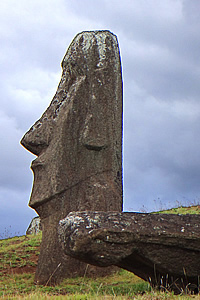
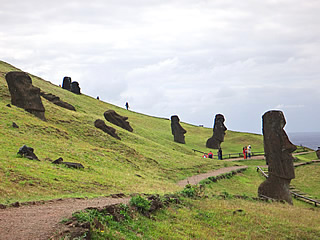
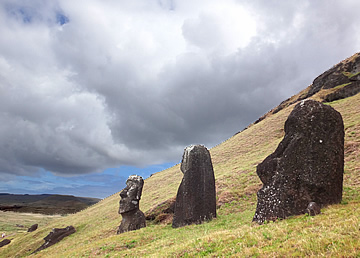
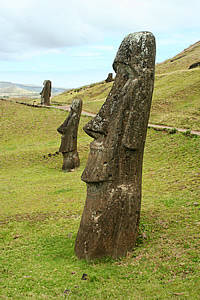
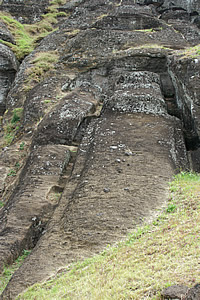
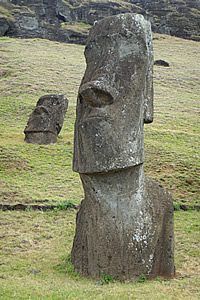
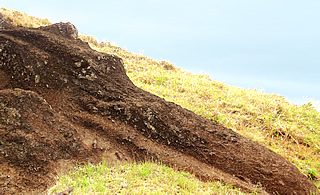
The quarry is where the moai were chiselled out of the rock, and is situated on the slopes of the volcanic crater Rano Raraku, one of several dotting the slopes of the extinct volcano Terevaka. Many moai stand buried up to the chest or neck or lie where they toppled.
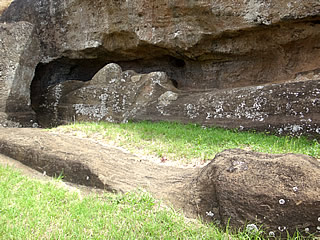
The technique seems to have been to carve out the basic shape of the statue lying in the rock, then to sculpt the front face. The statue was then chiselled around and underneath and levered into a wood-lined pit where the back face would be carved.
It seems an odd way to do it though, to complete half of the carving and then chip away to release the whole from the grip of the rock - how many must have cracked at this stage!
The part-buried vertical moai at the quarry are at this final stage, the pits having been filled in over time. The largest moai of all, up to 21m long, are barely begun, simply rough shapes outlined in the rock.
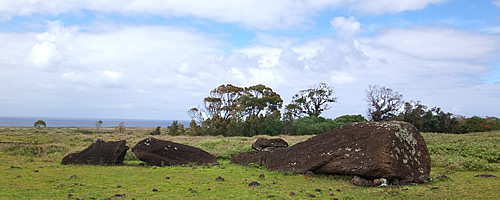
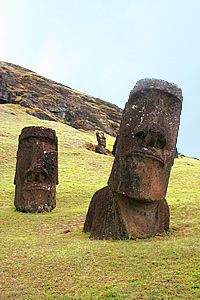
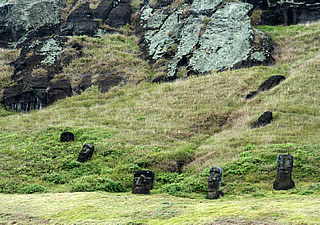
Somehow the moai were then transported to the shrine. It is a complete mystery as to how this was achieved: whether the statues were lying on their backs or standing upright on wooden sledges and hauled over wooden rollers. Another theory is that ropes were tied around the statue and it was gently rocked from side to side, in an upright position, and gradually moved forward. But the terrain is rough and incredible coordination would have been needed for a group of men to do this for a 4-10m statue.
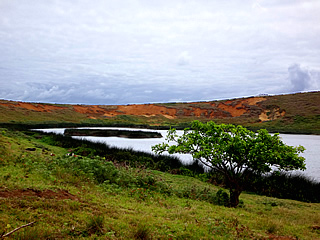
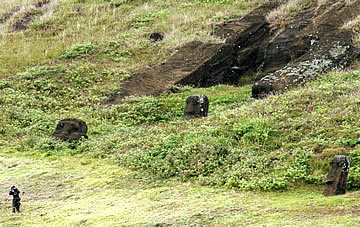
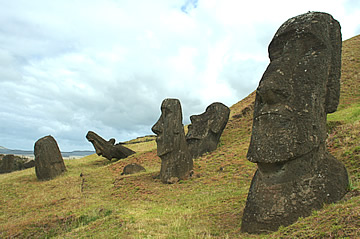
It is thought that the eyes, made from coral, were inserted only when the statue was placed in its final position and it was this which activated its power.
We made our way through the moai and up to the crater lake. Here there were many more moai in the same kind of state, part-buried or toppled on the sloping side of the crater above the water.
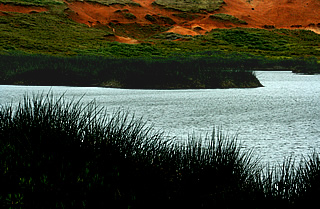
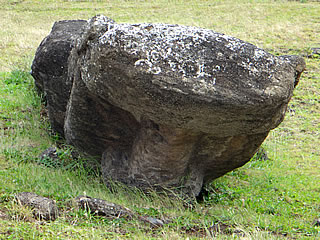
Hundreds were in the process of preparation at the quarry when it all came to a stop, many remain buried upright and many lie where they fell during transportation.
All the statues we saw at the quarry were elongated with long faces and long ears; these are later examples of the carving - earlier moai are more squat and rounded. The eyes are absent and there are no distinctive red topknots.
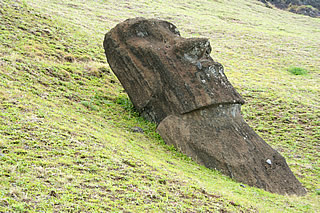
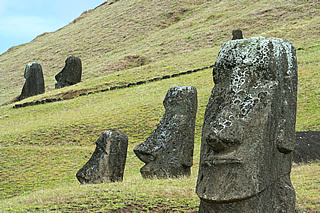
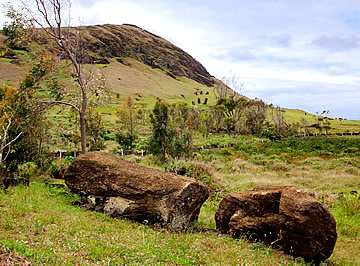
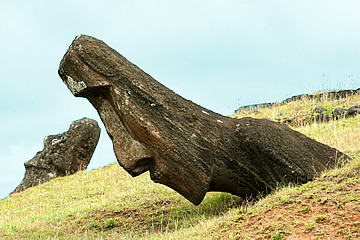
The largest moai to be transported from the quarry and successfully erected on a platform is found at Ahu Te Pito Kura, the "Navel of the Universe", on the east coast. It was 10 metres high, though now toppled and broken. Te Pito Kura was a location revered by the islanders. They believed that the spherical iron-containing ball near the sea shore was a source of power - it is weakly magnetised and warm to the touch. Our guide waved a compass over it to demonstrate the effect.
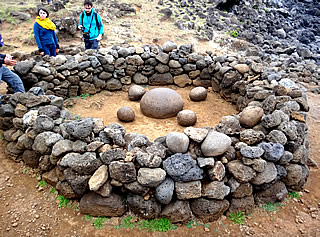
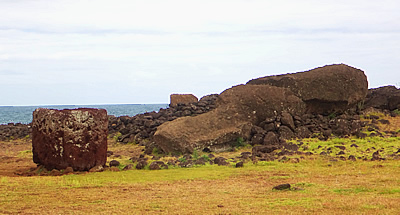
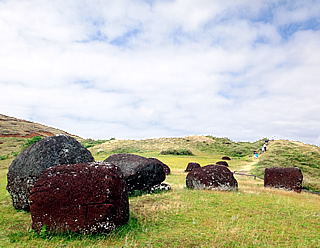
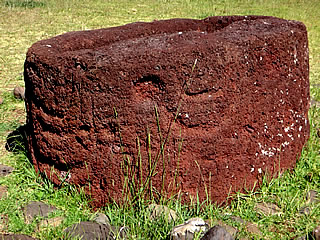
The topknots were quarried from another small crater area called Puna Pau closer to Hanga Roa. The roughly-shaped cylinders are up to 3m in diameter quarried from red volcanic rock. They had a recess on the underside which fit onto the head of a moai.
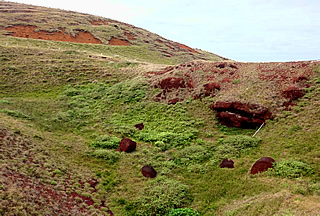
It is not known exactly what these red headpieces were meant to represent: possibly hair or a feather headdress.
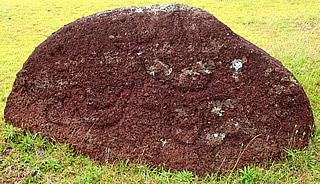
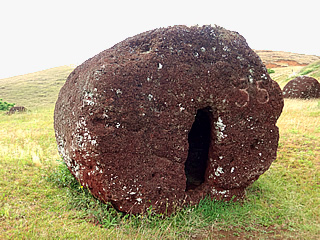
There are also some examples of rock-carved petroglyphs, but they are quite difficult to make out.
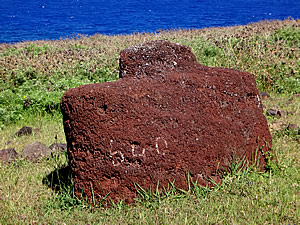

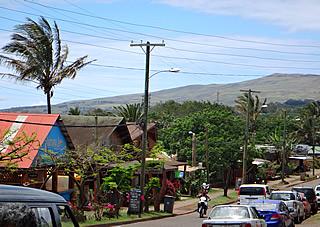
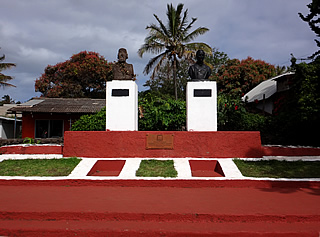
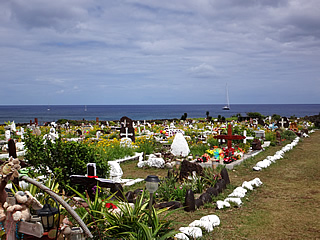
On the island it feels a little as if you have stepped back into the fifties: there is very little traffic, the roads, the few that exist, are wide and Hanga Roa itself feels a bit like "small town America". There are only a few thousand inhabitants and it seems a very peaceful place. We liked it very much.
To the west of the town is a small harbour with its own shrine, Ahu Hotake. It has two moai remaining standing right on the edge of the low cliff.
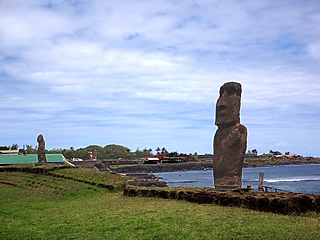
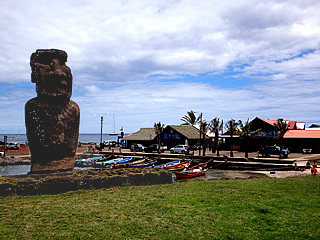
North of the harbour, past the colourful cemetery, is the multi-shrine complex of Ahu Tahai. Here there are three shrines or ahu: Ko Te Riku, Tahai, and Vai Ure, as well as the remains of the foundations of boat-shaped houses from the original settlements and wells in caves.
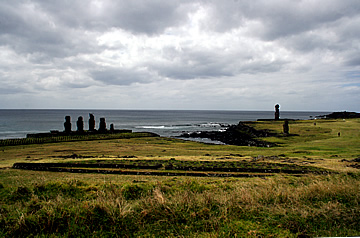
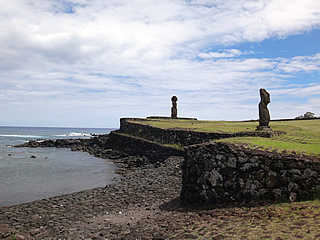
Behind the statues is an ancient harbour, little more than a sheltered landing place with a sloping ramp up to the level of the settlement.
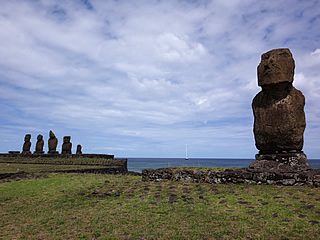
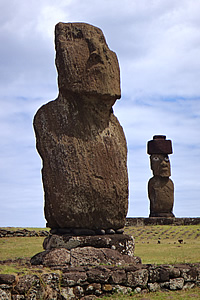
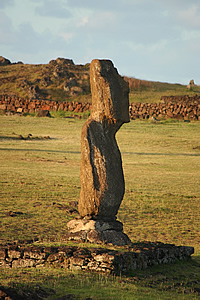
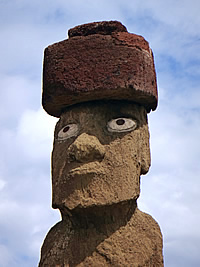
Ahu Tahai was the first shrine at this location and gives its name to the complex. The weathered statue is not so elongated and stands on a square base with no room for any others to be added, unlike all the other ahus we saw which were rectangular.
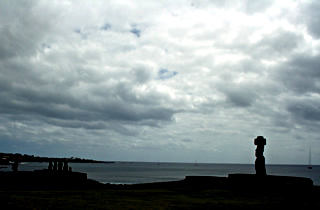
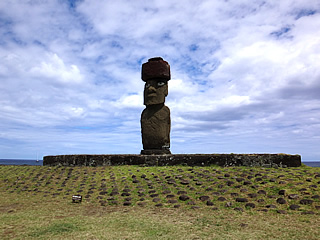
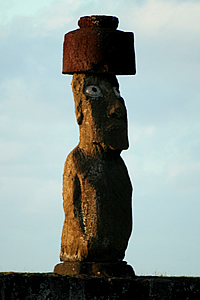
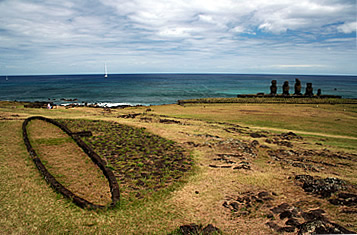
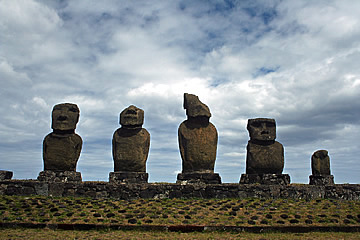
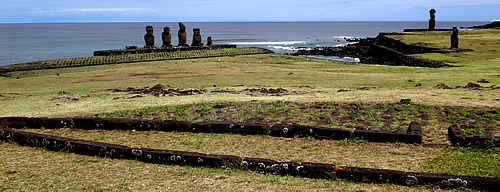
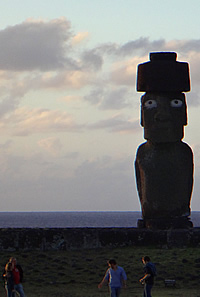

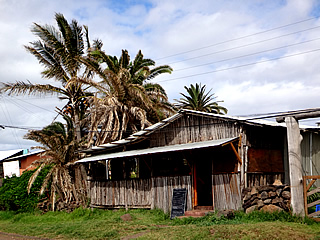
We had some excellent meals in Hanga Roa. The first day walking back from Tahai we were tired and hungry and stopped virtually at the first place we saw: Donde la Tia Sonia, - a roadside "shack" restaurant serving empanadas, one meat, one tuna and a bottle of beer certainly hit the spot.
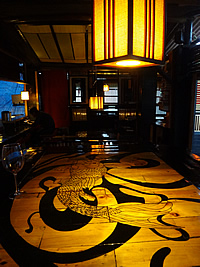
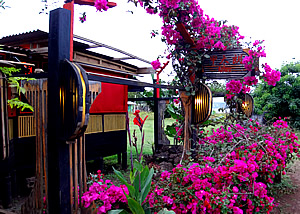
One of the most highly recommended restaurants on the island is the Japanese Kotaro which was very close to our hotel. It turned out to be one of the best meals of our whole trip. The proprietor prides himself in cooking for the individual and discusses your likes and dislikes before going off to his kitchen to prepare the dishes. A lovely soup and truly excellent tuna ceviche - top-quality fish and we both much preferred this to the Peruvian ceviche we had had in Lima. Fabulous chicken teriyaki and shrimp in a fantastic sauce. On top of this the glasses of excellent Merlot were enormous. The Swiss could learn a thing or two - there a glass is strictly 125ml - here it looked like 300!
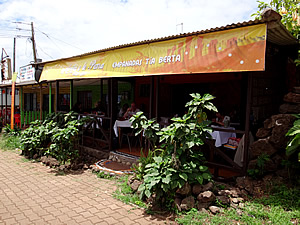
We also searched out Tia Berta at the top end of Avenue Atamu Tekena which also has a very good reputation. The empanadas here are truly first-rate. Tuna and a tuna and cheese in a beautiful pastry were succulent and enormous by European standards, though a bit messy to eat without cutlery!
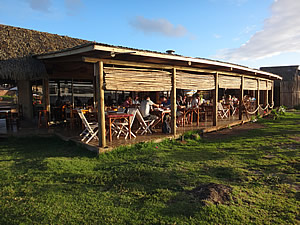
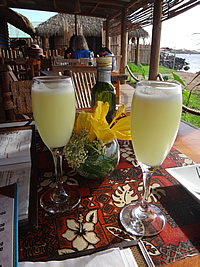
Ahu Tahai is the recommended spot for sunset so we reserved a table at Te Moana for dinner beforehand. It was a very good meal and sitting on the terrace as the sun dipped to the horizon, sipping excellent pisco sours while watching the surfers and scullers on the ocean is hard to beat.
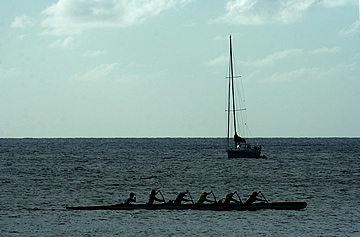
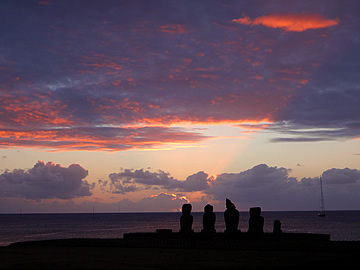
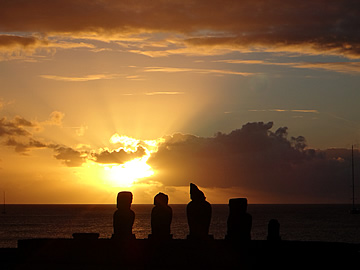

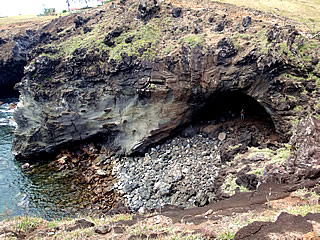
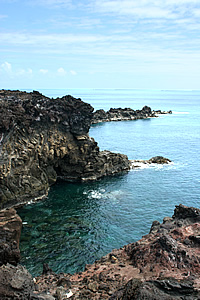
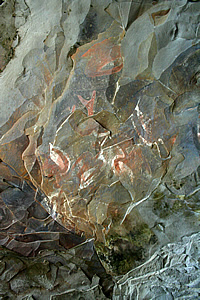
The ancestor cult began to wane as the population grew and resources became more scarce. By the late seventeenth century warfare had broken out between the clans, probably due to the pressure on resources, and many of the moai were toppled - an easy way to "destroy" the power of an enemy! The ancestor became less important in the rituals of the people and the cult of the Bird Man became more prominent, revolving around human competition and strength, a reflection of the power wielded by warriors.
In the cave of Ana Kai Tangata on the south-western tip of the island, there are pictograms depicting birds.
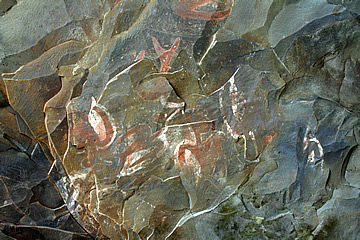
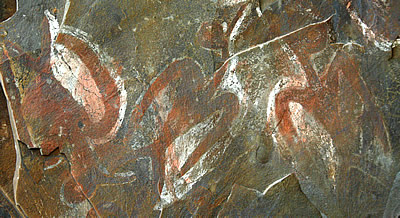
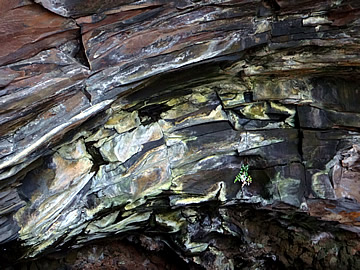
It's possible that the cave had links to the Bird Man cult, given the preponderance of bird paintings.
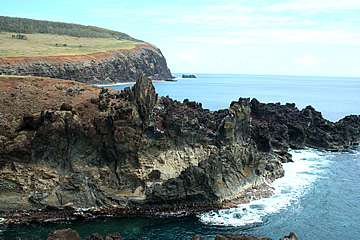
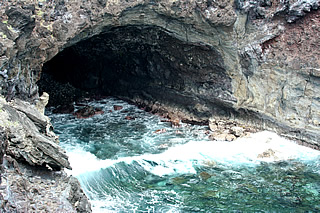
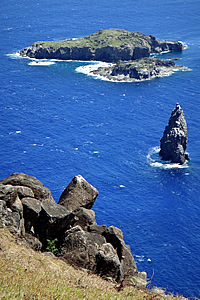
The coastline here in the south-west is particularly beautiful with steep cliffs dotted with caves, clear blue water and pristine white surf.
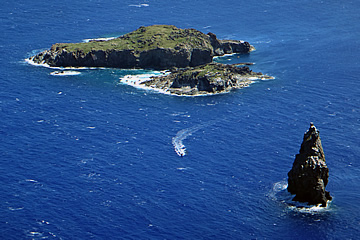
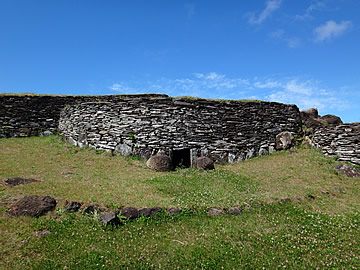
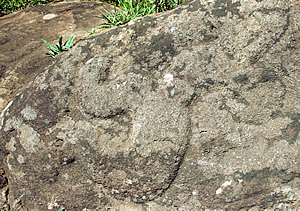
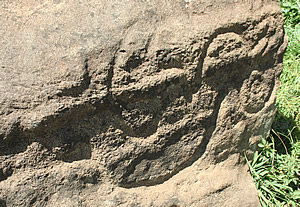
The god of the Bird Man cult was Makemake. Each year a Birdman was chosen by a competition to collect the first sooty tern egg from the island of Motu Nui off the south-western tip of the island near the ceremonial village of Orongo. The contenders each appointed a representative to swim out to the island, collect an egg, swim back and climb the 250m cliff face to present the egg intact to their patron, the winner being the first to complete this demanding task.
The swimmers had over a kilometre of possibly rough, shark-infested seas and steep cliffs on both shores to negotiate.
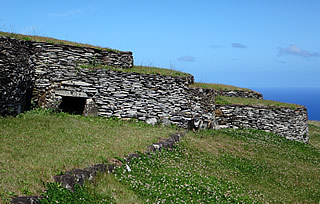
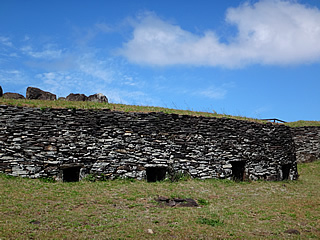
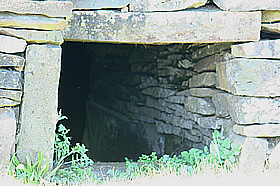
The ceremonial village of Orongo was built into the hillside between the cliff top and the lip of the volcano Rano Kau. A series of low, linked, curved-walled houses with narrow entrances face the sea.
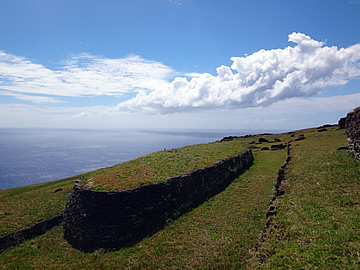
The walls of the houses are very thick and constructed of rough dry-stone walling. The entrances are small, low to the ground. Everything looks to be designed to keep the homes snug and warm, no easy feat in a position which experiences very strong winds.

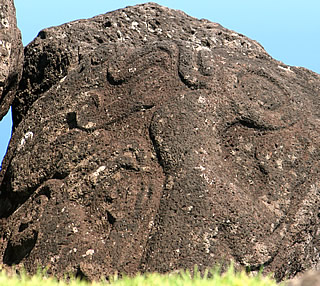
Behind Orongo, at the very top of the ridge, are a number of well-preserved petroglyphs, carved onto boulders. Unfortunately they are fenced off and can only be viewed from some distance away - a long lens and binoculars are useful here!
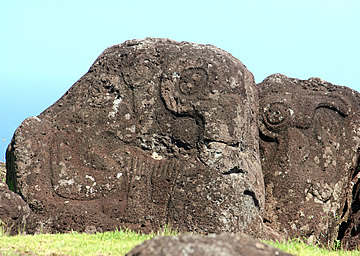

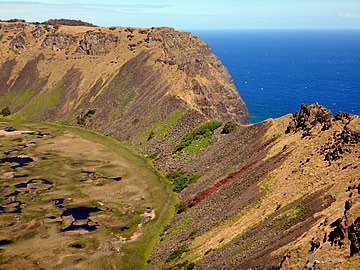
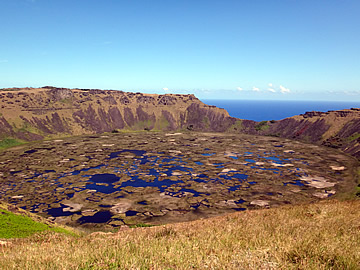
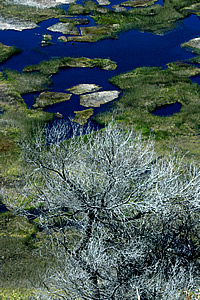
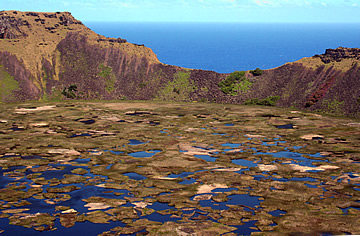
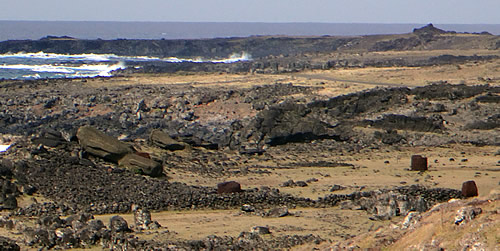
In the eighteenth century the Europeans began to arrive, the first, a Dutch expedition arriving on Easter Sunday 1722, gave the island its name. In 1770 the Spanish made an appearance, discovering a depleted population living mostly in caves or boat-shaped houses.
Four years later Captain James Cook, the famous English explorer, came to Rapa Nui. It is from his accounts that we learn of the toppled moai and the ravaged landscape with very few trees, none over ten feet high.
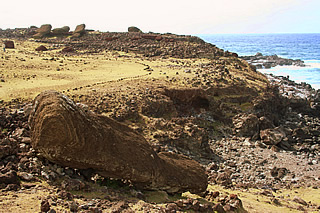
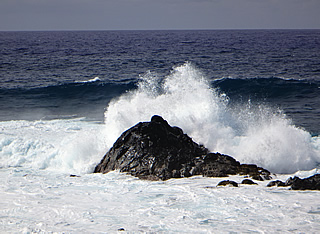
Ahu Akahanga on the south coast has the remains not only of at least four platforms and many toppled moai, but also an ancient village. Boat-shaped foundations of homes, outdoor hearths and an original cave-dwelling give a little insight into the lives of the Easter Islanders. Each open hearth served maybe three homes. Layered between banana leaves and hot lava rocks were meat at the lowest level, then fruits and chicken, then fish,the softest food, at the highest level.
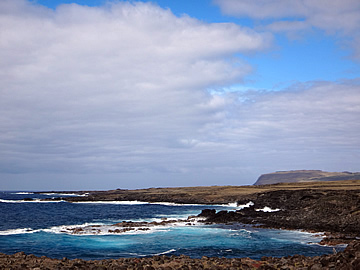
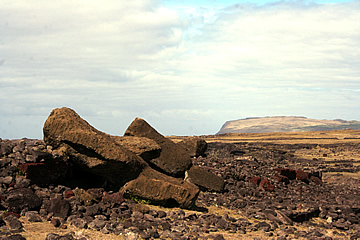
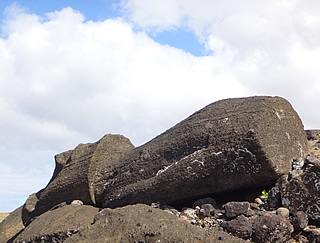
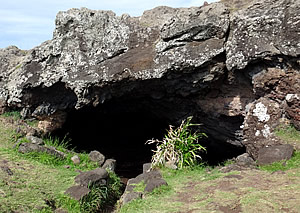
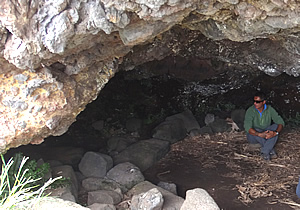
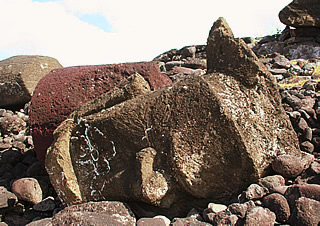
It is said that in front of the main platform of Akahanga the original founder of Easter Island, the first king, Hotu Matua is buried.
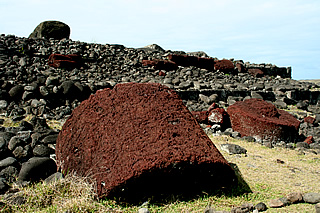
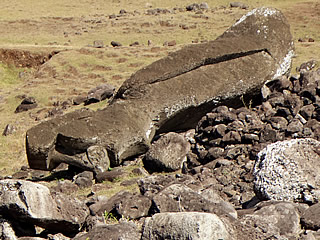
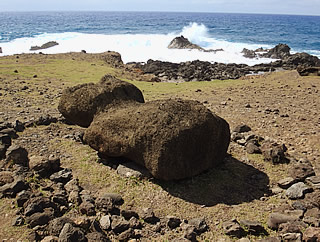
Some of the moai tumbled in front of the main platform, others behind, still more can be found in the sea. On the seaward side a squat moai lies flat on its back, from its shape much earlier than the others at this site.
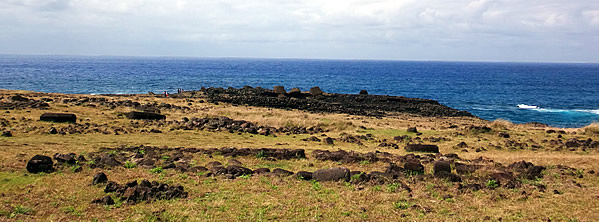
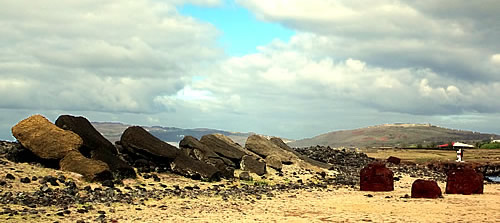
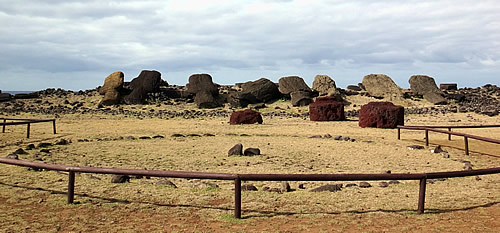
Usually in front of the platforms there is a ceremonial circle marked out. The best example we saw of this was at Ahu Vaihu to the west of Akahanga. Vaihu is an impressive ahu with a long platform, eight toppled moai and attendant pukau.
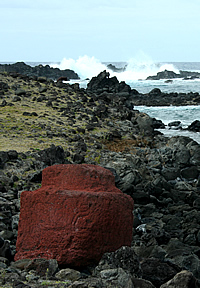
We saw pukau at Ahu Vaihu with traces of decorative carving.
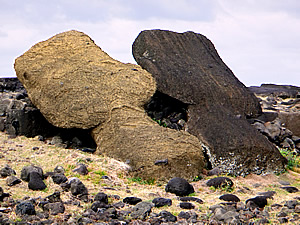
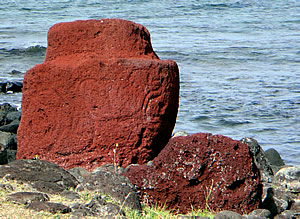
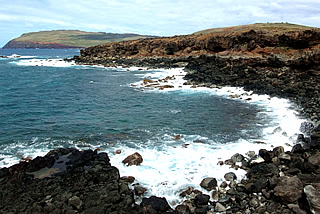
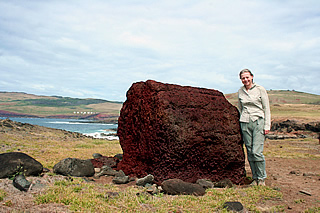
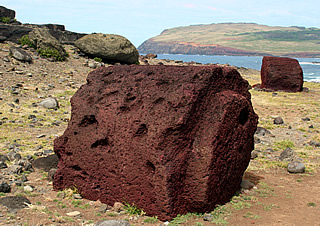
West of Vaihu more topknots are scattered at the site of Ahu Hanga Poukura on the rocky south coast, a wind-swept place popular with surfers. This is one of the less-visited shrines and the fallen moai are becoming buried.
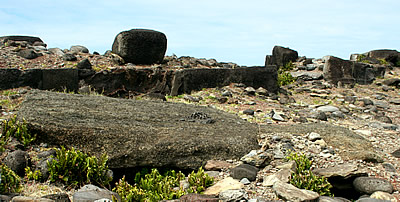
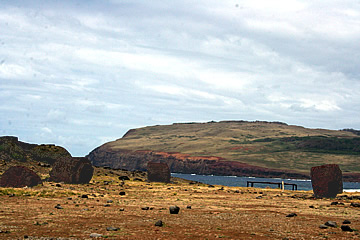
More explorers arrived in the nineteenth century, many looking to exploit the island in some way. In 1862 Peruvian slavers took around a thousand islanders back to Peru as forced labour. Bishop Jaussen of Tahiti, on learning of their fate, shamed the authorities into returning them to their homeland, though only around 10% had survived. Sadly, many died on the journey due to smallpox and those who survived infected the remaining inhabitants of the island causing many deaths and leaving only a few hundred alive.
Catholic missionaries suppressed local customs, commercialisation exploited the land for wool and the people were variously subjugated to Chilean imperial and military rule until the mid-twentieth century. In 1967, however, a regular commercial air link was established between Santiago and Tahiti using Rapa Nui as a refuelling stop and the island became connected to the outside world.
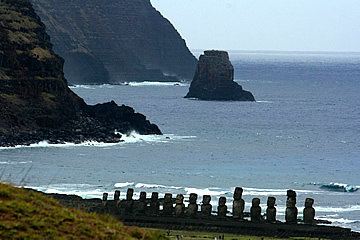
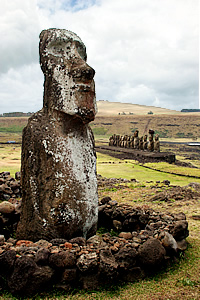
Today, though not independent, the island enjoys a special status, granted in 2008, which gives greater autonomy than in the past. The island has a burgeoning tourist industry, though some of the locals feel it has reached a level with which they are happy and don't want it to increase any more. There has been outside help to restore some of the shrines. Magnificent Ahu Tongariki was destroyed by a tsunami in 1960 and restored in the early 1990s in a collaborative effort between a Japanese company and Chile.
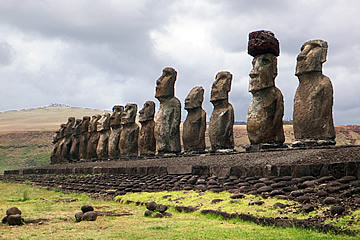
Ahu Tongariki is truly spectacular. It was probably the largest of the ahus ever built on Easter Island and could have accommodated maybe twice as many moai.
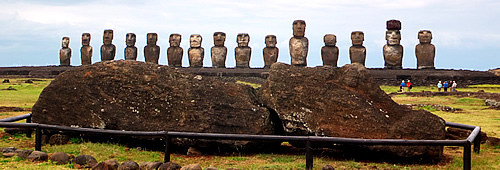
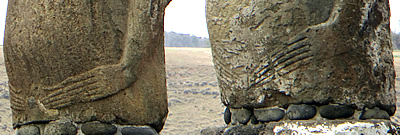
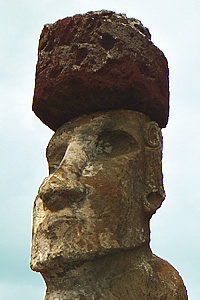
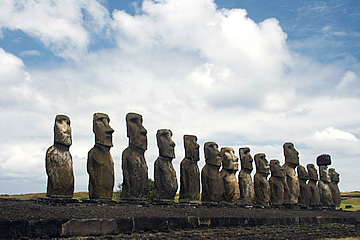
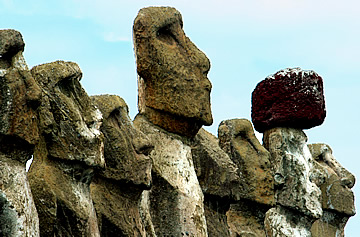
The carved hands are still very well-defined, reflecting the fact that most of the moai were probably toppled forward so the front face was protected through the centuries. Only one of the moai has a pukao but several still show traces of beautifully carved ears.
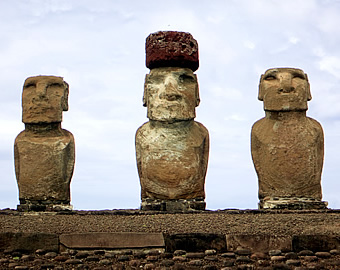
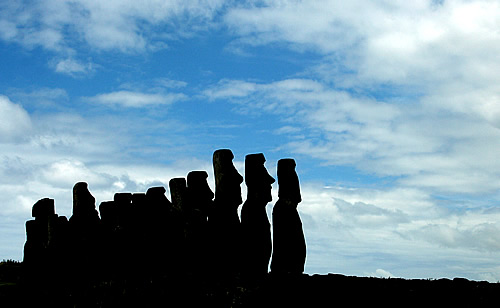

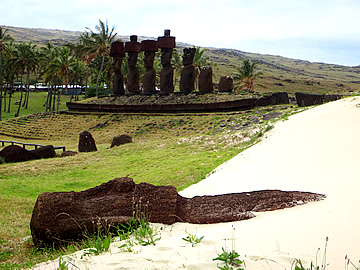
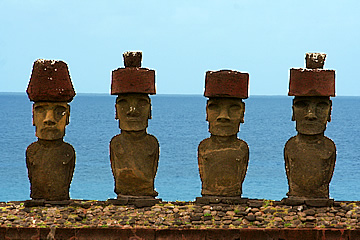
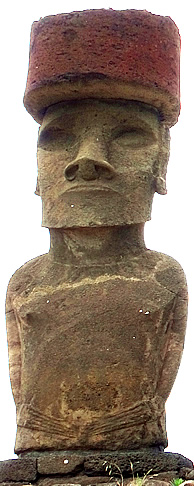
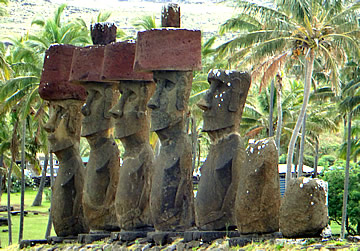
Anakena is another beautiful setting, quite unique on Easter Island, a curving sandy bay with exquisite moai on two platforms.
Of all the moai we saw these probably had the best-preserved, beautifully carved, ears. The breast bone and nipples are also easily discernible.
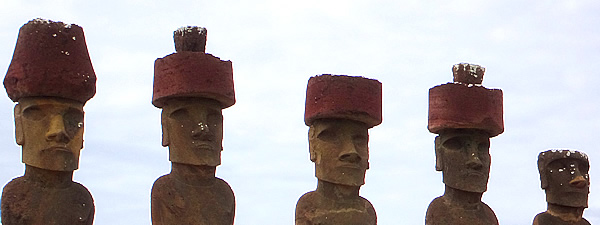
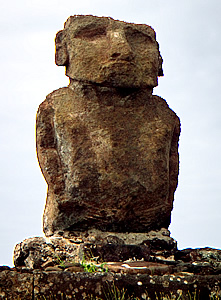

The statues have traces of caving on their backs which may be representative of tattooed buttocks. Also each has a faint curve at waist height, perhaps representing some kind of belt.
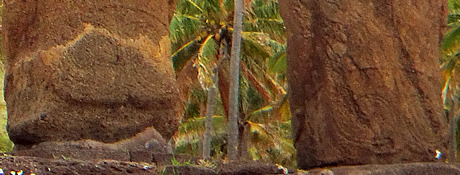
Behind the main platform of seven moai is a much older ahu with a squat, very weathered moai. It is very atmospheric viewed against the light from across the bay.

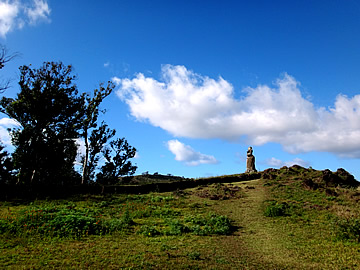
On our final day we had an afternoon flight back to Santiago so decided to spend the morning walking to Ahu Huri a Urenga about 4km from our hotel. It is not too difficult to find and well worth the effort.
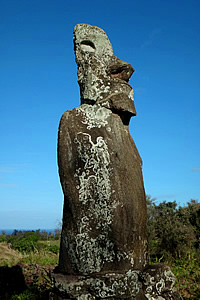
It was a glorious morning and the single moai stands in splendid isolation on the ahu on a rise in the ground.
A usual it faces away from the sea.
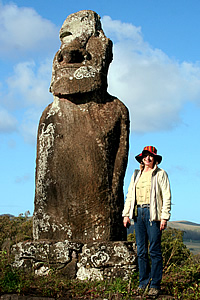
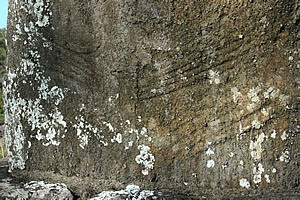
The moai is unusual in that it has four hands carved on it, though we could only really make out three as white lichen is gradually covering the statue.
There was no-one else around and it was very peaceful. I found this to be one of the most atmospheric of the ahus we visited. A fitting end to our visit to this fascinating Pacific island.
